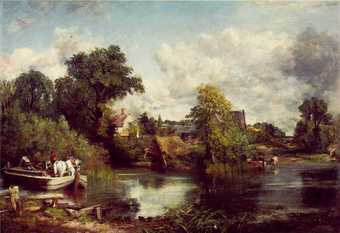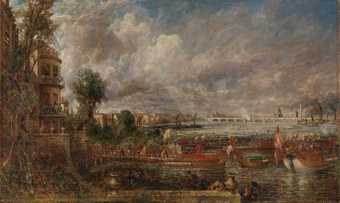Given the extent to which Constable elaborated The Cornfield in the studio, incorporating elements from the Old Masters and (by his own confession) adding rather more ‘eye-salve’ than usual, it is perhaps surprising that, when exhibited at the Royal Academy in 1826, the picture was described by one critic as a ‘specimen of genuine English scenery’. Of course what might have been considered ‘genuine’ in the early nineteenth century – in the years before Impressionism had given rise to new ways of seeing and evaluating landscape – was a relative matter. Certainly Constable’s landscapes were generally more ‘naturalistic’ in appearance – even those made in the studio – than those of his contemporaries, for they depended on years of careful study on the spot. Moreover, The Cornfield, unlike most of his other exhibition landscapes of the 1820s, was directly based on a picture – the Tate canvas – he had painted outdoors.
It is, however, much more than a representation of a real scene in Suffolk. Constable had been born and brought up in the area of East Bergholt, and his memories of the countryside of his childhood had helped to shape his ambitions to become a painter. His landscapes, especially those painted in the second half of his career following his move to London, are landscapes of association, into which he projects his own feelings. Indeed, sometimes they are landscapes of nostalgia.
The Cornfield features the path leading from East Bergholt to Dedham – Fen Lane – along which Constable walked to school every day, and some scholars have suggested that the young boy drinking in the left foreground might be a portrait of the artist himself. This is plausible if one reads the painting as containing Wordsworthian resonances about the innocence of childhood, or of the restorative powers of nature as perceived through memory.
The critical fortunes of The Cornfield have varied over time. A print made by David Lucas in 1834 had helped to disseminate the image to a wider audience during Constable’s lifetime. However, the picture was to grow in fame after the artist’s death in 1837 when it was purchased by subscription for presentation to the recently founded National Gallery, becoming the first of his works to enter a public collection. Its accessibility served to enhance its popularity, and by the mid-nineteenth century one French critic was lamenting that it had not ended up in the Louvre. But in the wake of Impressionism and modernism, The Cornfield – and most of Constable’s large exhibition canvases – fell out of favour with English critics, who preferred the looser and more expressive handling of his sketches.
Together with Constable’s The Hay Wain 1821, which entered the National Gallery in 1886, The Cornfield has, however, long been a consistent favourite with the British public. It has come to be appreciated as an image of a rural, natural, fertile and quintessentially English landscape that, most especially, reassures and soothes in the face of urbanisation and change. It is not for nothing that details from the painting – of the boy drinking and of the cornfield itself – were used for advertisements in the 1980s, for mineral water and breakfast cereal respectively. When that critic referred to The Cornfield as a ‘specimen of genuine English scenery’, little can he have realised that his assessment would, for rather different reasons, persist to this very day.




